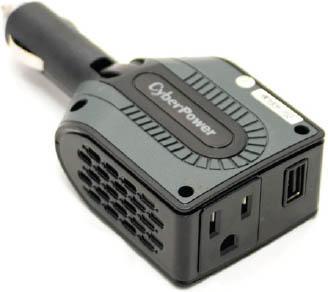19. POWER ON THE GO
![]()
WHETHER YOUR TRAVELS carry you out of the state, overseas, or off the grid, you’ll want to have a simple and convenient power solution for maintaining your gear on the go. As with all other travel gear, the best power solutions are compact, versatile, and easy to use.
Keeping Your Camera Running
For starters, it’s a good idea to purchase a couple of extra batteries for your camera before a big trip. You can save money by picking up compatible off-brand batteries, but I have found that they hold an inferior charge over time. I recommend sticking with the batteries manufactured by your camera brand. It’s better to spend a little money up front for a more reliable product. That said, all batteries can eventually go bad, regardless of manufacturer, so make sure your batteries are in good working order before a trip.
All cameras utilize battery power differently. Some are great at “going to sleep” to save battery life between shots, whereas others constantly drain power. My Canon tends to be great when it comes to battery life, but I avoid certain settings and features that drain the battery quickly:
- GPS can be a big battery drain because your camera is constantly trying to triangulate itself. If I don’t specifically need GPS data for my shots, I keep it turned off.
- Live View is a battery killer. As a DSLR user I have the luxury of an optical viewfinder, which uses no additional battery power, but if you’re shooting with a mirrorless camera, you may have more significant power usage issues. Consider carrying extra spare batteries to make sure you can keep shooting as long as possible.
- Turn off automatic image review to keep your screen from showing off every single shot after you take it. It will save you significant battery life over the course of the day, and if you want to look at your shots they’re still available at the touch of a button.
- Turn off your camera when it goes back in your bag. Even if your camera is “sleeping,” getting jostled around in your bag may cause it to wake back up and use power. If my camera is out of my bag, then I keep it turned on for quicker shooting; if it’s put away, then I turn it off. Just remember that many cameras reset bracketing and other custom settings when they are switched off, so you’ll have to manually reapply those settings when you switch the camera back on.
- If your battery is on the verge of death and you want to get a couple more shots before it goes, use manual focus and turn off image stabilization to help minimize the power required from your camera to shoot.
- Very cold temperatures will drastically reduce battery life. Keep your spare batteries in a shirt pocket or an interior coat pocket to use your body heat for better battery life. Even if a cold battery seems dead, sometimes putting it close to your body’s warmth will get some more life out of it.
- Be sure to create a system for yourself so you’ll be in the habit of recharging your camera batteries at least once a day. All the dead batteries in the world will do you no good when you want to go out and shoot.
Adapters and Converters
For many international destinations, you’ll need not only an adapter to fit foreign outlet shapes, but potentially need a power converter to make sure your gear is receiving the appropriate voltage of current. In the United States, devices are intended to use our 110-volt system, but many are designed to accept anywhere between 100 and 240 volts. Check your camera battery and laptop chargers to see the accepted voltage range before you travel. You may be able to get away with using just an adapter rather than a power converter as well, but if not, it’s best to plan ahead and find a converter that suits your charging needs.
Maximize Outlets
American hotels have figured out that we need roughly eighteen outlets in every room to charge our plethora of devices. Foreign hotels are often a different story. I travel with a small power strip with surge protection. I like being able to charge multiple camera batteries, my phone, and my laptop at the same time if necessary. Because electricity can be spotty in some of the places I visit, I like the added security of knowing a power surge or short won’t damage my gear.
Power Packs
For charging phones and other small devices, portable power packs can be a great asset while traveling. I’m always a big fan of knowing I can recharge without being tethered to an outlet, especially when I’m trying to maximize my travel time for shooting. Because most power packs feature only USB ports, they aren’t a realistic solution for charging camera batteries.
Car Charging
While traveling, it’s generally a good idea to top up your charges when you have the opportunity, rather than waiting until all your batteries are drained. Recharge every night at your hotel, but if you’ll be traveling by car at all, pack a car power inverter to allow you to use any of your traditional chargers on the go. I use a CyberPower power inverter (Figure 19.1) that allows you to use the cigarette lighter as a regular three-prong outlet and a USB charger.
Solar Charging
For longer off-the-grid journeys, solar charging has recently become a much more viable option. A variety of solar-charging kits are available in the $150–$600 range, depending on how quickly and how many devices you need to charge. Because solar-charging systems aren’t usually functional if you’re actively moving or hiking, they are most effective when set up at a campsite with plenty of all-day sun. Most kits will come with a single solar panel or a panel array and a power pack to store the power and transmit it to your devices. Solar technology is rapidly improving to become lighter and more portable, so shop around to find the best system for you.
19.1 Car charging like a pro.

